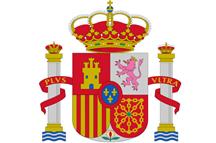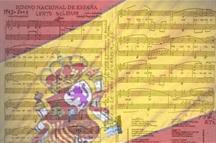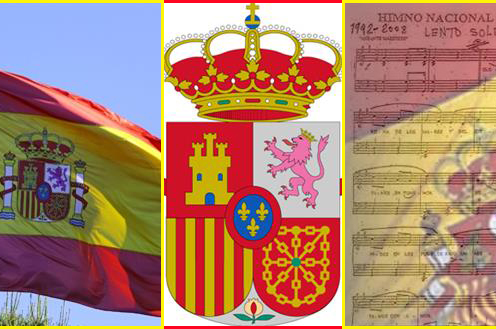The Spanish National Flag
Pursuant to Article 4.1 of the Spanish Constitution of 1978, "the Spanish National Flag consists of three horizontal stripes - red, yellow and red, each red stripe being half the width of the central yellow stripe".
In addition, the Spanish national flag is governed by:
Law 39/1981, of 28 October, governing the use of the Spanish flag and the use of other flags and standards (Official State Gazette Nº 271, of 12 November)
Royal Decree 441/1981, of 27 February, which defines the colours of the Spanish Flag in technical terms (OSG Nº 64, of 16 March)
Royal Decree 1511/1977, of 21 January, which approves the Regulations on Flags and Standards, Crosses, Ensigns and Badges (OSG Nº 156, of 1 July 1977)
Historical Background
The origin of the current Spanish Flag dates back to the reign of Carlos III of Spain (1759-1788). Three types of flag coexisted in Spain at the time: the royal standard, the military flags and the Spanish navy jack. Most countries were using jacks that were predominantly white. This caused identification problems and confusion between warships at sea. To solve this problem, Carlos III of Spain commissioned his Minister of the Navy, Antonio Valdés y Bazán, with designing a replacement for the Spanish navy jack.
The king chose two of the 12 sketches presented to him - on which he adjusted the dimensions of the stripes. He declared the first to be used as the War Ensign and the second as the Civil Ensign by means of the Royal Decree of 28 May 1785.
 The chosen flags
The chosen flags
During the reign of Carlos IV of Spain (1788-1808), the General Orders on the Spanish Navy of 8 March 1793 made extensive use of the so-called red-weld flag [from rojigualda and the more archaic use of gualda to refer to the colour of the central yellow stripe] in maritime plazas, castles and coastal defences, and it became known as the Royal Flag.
A phenomenon emerged during the Spanish War of Independence (1808-1814), in which a series of non-regulation flags proliferated. A number of sailors lent their services to terrestrial campaigns and, for the first time, bi-colour ensigns were seen throughout inland Spain.
Under the reign of Queen Isabel II of Spain (1833-1868), use of the bi-colour flag spread to the Army and the Spanish flag was thus unified. The Royal Decree of 13 October 1843 provides for the replacement of all flags, standards and badges, and military ensigns with other new red-weld ones.
Subsequently, the Instructions on Navy ensigns, flags, honours and salutes, of 13 March 1867 once again explicitly describes the flag to be used by ships, arsenals and maritime plazas.
Amadeo I of Spain (1871-1873) respected the heraldry of the Spanish Flag. During the First Republic (1873-1874), plans were drawn up to include a purple stripe to replace the lower red stripe. However, no change was actually made.
During the reign of Alfonso XII of Spain (1874-1885), an Instruction on naval ensigns, flags, honours and salutes was enacted on 10 December 1878. Article One of this document defines the national flag in the same terms as the aforementioned Instruction of 1867.
Under the Interim Government during the Second Republic (1931-1939), a decree was enacted on 27 April 1931 requiring the adoption of a tricolour national flag comprising "three horizontal strips of equal width; the upper being red, the central being yellow and the lower being dark purple".
Shortly after the outbreak of the Spanish Civil War (1936-1939), the red-weld flag was reinstated among rebel troops. After the Military Uprising (18 July 1936), a number of different flags proliferated among troops. To prevent this, the Chairman of the National Defence Council - General Cabanellas - signed the Decree of 29 August 1936 whereby the traditional flag was recovered. The Sole Article of this document states: "The red and weld bi-colour flag is re-established as the Flag of Spain".
A few years later, during the dictatorship of General Francisco Franco (1939-1975), the Decree of 11 October 1945 approved the New Regulations on Ensigns, Flags and Badges that governs their use and form, and defined the characteristics of the three types of National Flag for units of the Armed Forces, warships and buildings.
Following the death of Franco in 1975 and the restoration of the House of Bourbon through King Juan Carlos I of Spain, these Regulations were replaced by Royal Decree 1511/1977, of 21 January, which approves the Regulations on Flags and Standards, Crosses, Ensigns and Badges.
Current legislation is based on the Spanish Constitution of 1978, which defines the Spanish Flag in its Article 4.1.
The Coat of Arms
 The current Spanish Coat of Arms reflects much of the country's history. The elements of which it is composed have a long tradition dating back more than nine centuries.
The current Spanish Coat of Arms reflects much of the country's history. The elements of which it is composed have a long tradition dating back more than nine centuries.
The Coat of Arms of Spain is regulated by:
Law 33/1981, of 5 October, on the Coat of Arms of Spain (Official State Gazette No. 250, of 19 October 1981)
Royal Decree 2964/1981, of 18 December, making public the official model for the Coat of Arms of Spain (OSG No. 221, of 15 September)
Royal Decree 2267/1982, of 3 September, giving technical details of the colours of the Coat of Arms of Spain (OSG No. 221, of 15 September)
Historical background
The heraldic process of the Coat of Arms of Spain has passed through the following periods:
The Trastámara Dynasty: The Coat of Arms of the Catholic Monarchs (1474-1492) was composed of the Coat of Arms of the Kingdoms of Castile, Leon and the Crown of Aragon. After the conquest of Granada, the coat of arms of the Kingdom of Granada was incorporated.
The Habsburg Dynasty: Initially (1504-1506) it included the arms of Bourgogne, Flanders, Brabant and Tyrol. Carlos I stamped the coat of arms with the imperial crown and added the Pillars of Hercules and the motto "Plus Ultra", as well as the Golden Fleece. Felipe II, Felipe III and Felipe IV and Carlos II, whose reigns lasted from 1556 to 1700, used this coat of arms without the imperial crown. In 1580, Felipe II incorporated the arms of Portugal.
The Bourbon-Anjou Dynasty: The coat of arms of Felipe V (1700-1759) incorporated the fleur-de-lis of the house of Bourbon with an outline in gules (red). It continued to use the Golden Fleece and added the Order of the Holy Spirit in form of a necklace. Carlos III (1759-1788) added the arms of the Duchies of Parma and Tuscany and replaced the Order of the Holy Spirit with the order that bears his own name. Carlos IV used his father's model.
Bonaparte Dynasty: José I divided the shield into six quarterings: 1 Castile, 2 Leon, 3 Aragon, 4 Navarre, 5 Granada and 6 the New World, represented by the Pillars of Hercules. He also added an inescutcheon with the Bonaparte coat of arms.
The Bourbon-Anjou Dynasty: Fernando VII recovered the coat of arms of his ancestors and his daughter Isabel II used the same model.
Provional Government (1868-1870): A ruling by the Royal Academy of History unified the Coat of Arms of Spain with the following quarterings: 1 Castile, 2 Leon, 3 Aragon, 4 Navarre and 5 Granada. It drew a nebuly, stamped it with a mural crown, removed the shield with the coat of arms of the Bourbon-Anjou dynasty and added the Pillars of Hercules, without crowns.
The Savoy Dynasty (1870-1873): Continued with the previous coat of arms, re-established the royal crown and added an inescutcheon with the family arms.
The First Republic (1873-1874): Re-established the mural crown and removed the arms of Savoy.
The Bourbon-Anjou Dynasty: Alfonso XII and Alfonso XIII re-established the royal crown and added the fleurs-de-lis with the gules (red) border of their family and incorporated the necklace of the Golden Fleece.
The Second Republica (1936-1939): Re-established the mural crown and eliminated the arms of Bourbon-Anjou, using the same arms as in the First Republic.
Dictatorship of general Franco (1938-1975): Used heraldic devices similar to those of the Catholic Monarchs, replacing the arms of Aragon-Sicily by those of Navarre, adding the Pillars of Hercules and the motto "una, grande y libre" (one, great and free).
The Transition Period (1977-1981): Royal Decree 1511/77 of 21 January, approving the Regulation on Flags, Insignia and Badges, altered the design of the motto on the coat of arms, but the main change consisted of presenting the eagle of Saint John rising, or about to take flight, shielding the Pillars of Hercules under his wings, rather than outside as previously.
This coat of arms was in force from 1977 until it was replaced by the current one in 1981, under Law 33/1981, of 5 October, governing the Coat of Arms of Spain.
The National Anthem
 The Spanish National Anthem is traditionally known as the "March of the Grenadiers" or the "Spanish Royal March". It has no words, and there are two versions: complete and shortened. Either of them must always be performed in full and without interruption.
The Spanish National Anthem is traditionally known as the "March of the Grenadiers" or the "Spanish Royal March". It has no words, and there are two versions: complete and shortened. Either of them must always be performed in full and without interruption.
The National Anthem is regulated by:
Royal Decree 1560/1997, of 10 October, which regulates the National Anthem (Official State Gazette No. 244, of 11 October 1997; errors corrected in OSG No. 253, of 22 October 1997)
Royal Decree 1543/1997, of 3 October, on the acquisition by the State of the rights to use certain musical works and the assignment of their administration to the Ministry of Education and Culture (OSG No. 233, of 29 September 1998)
Royal Decree 2027/1998, of 18 September, accepting the free assignment by maestro Francisco Grau Vergara of the performing rights resulting from the revision and orchestration of the National Anthem and the attribution of the administration of these rights to the Ministry of Education and Culture (OSG No. 233, of 29 September 1998)
Historical background
The origins of the National Anthem lie in a military piece called "La Marcha Granadera" (March of the Grenadiers), whose author is unknown. It first appeared in 1761 in the Libro de Ordenanza de los toques militares de la Infantería Española (Book regulating the military calls of the Spanish Infantry). King Carlos III declared it the Honour March on 3 September 1770, although it was the custom and popular roots that led to this composition emerging as the National Anthem, with no written provision.
Spanish people considered the "March of the Grenadiers" their National Anthem and called it the "Royal March", because it was played at public events when the King, Queen or Prince of Asturias were present.
In 1870, General Prim organised a national competition to create a national anthem. The jury were unable to select a winner as none of the marches presented was of higher quality than the "March of the Grenadiers" and they recommended that it should be kept as the National Anthem.
The Royal Ordinance dated 27 August 1908 laid down that military bands should play the "Royal Spanish March" and the "Call of the Infantes" arranged by the Chief Musician of the Royal Corps of Halberdier Guards, Maestro Bartolomé Pérez Casas.
The "Royal March" has always been the Spanish National Anthem, except during the Second Republic (1931-1939), when the "Riego Anthem" was adopted.
During the Civil War (1936-1939), General Franco re-established the "March of the Grenadiers" as the National Anthem by Decree dated 27 February 1937, but a new decree had to be published in the Official State Gazette (BOE) on 17 July 1942 to enforce the decree. The decree did not include any score, so the version by Maestro Pérez Casas was understood to continue as the official version.
It was not until 1997 that the State acquired the rights to the composition, which belonged to the heirs of Maestro Pérez Casas, through Royal Decree 1543/1997, of 3 October.
Following approval of the Spanish Constitution in 1978, the use of the Flag was regulated by Law 39/1981 and that of the Coat of Arms of Spain by Law 33/1981. It seemed appropriate to provide a legal basis for the National Anthem.
The Presidency of the Government pushed through the creation of a working group to complete the regulations whereby the symbols representing the Spanish nation would be governed. The group was made up of members of the Music Section of the Royal Academy of Fine Arts of San Fernando and representatives of ministerial departments. It appointed Maestro Francisco Grau, Colonel Director of the Music Unit of the Royal Guard, with the task of creating a new arrangement for the National Anthem.
Following a favourable report from the Royal Academy, a new version of the "March of the Grenadiers" was finally approved. It respected the harmonisation of Maestro Pérez Casas, while returning to the roots of the piece's original composition and tonal aspects.
Currently, the National Anthem is regulated by Royal Decree 1560/1997, of 10 October, which describes the musical score, establishes two versions, complete and shortened, and when each has to be used.
Maestro Grau has ceded all the rights to use of his work to the Spanish State under Royal Decree 2027/1998, of 18 September.
Bibliography
"SÍMBOLOS DE ESPAÑA". Centre for Political and Constitutional Studies.





